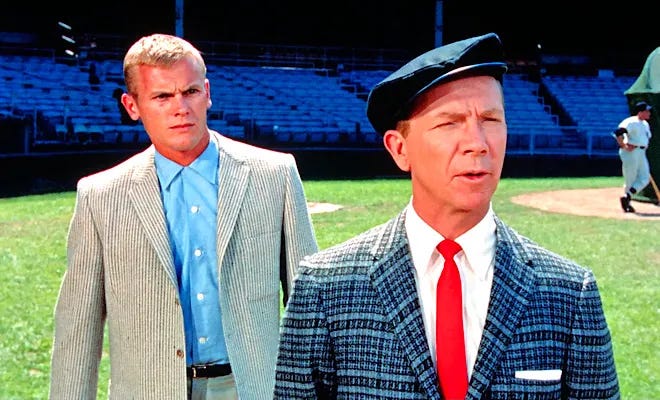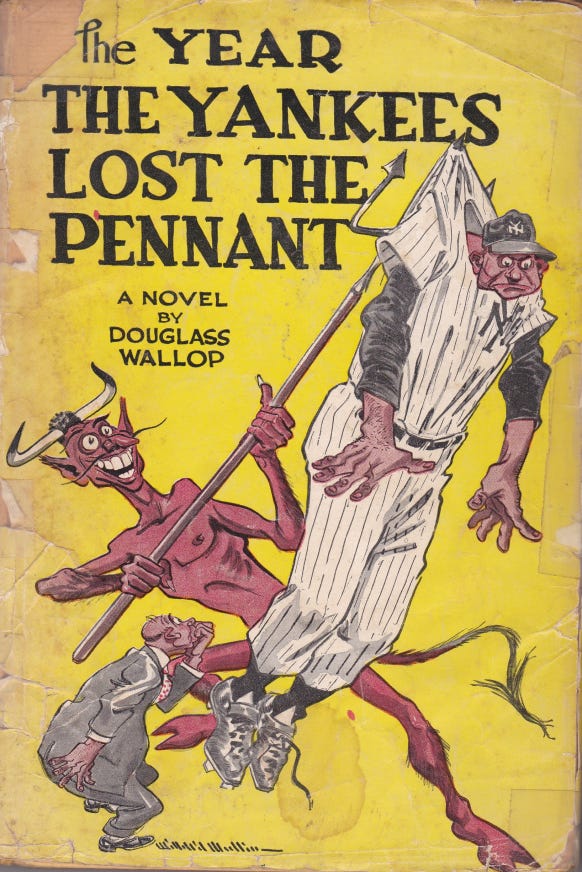Andrew Sharp is a retired daily newspaper journalist and life-long baseball fan. He write biographers of players for SABR's Bio Project and game stories for the Games Project. To read more of his work, please visit Washington Baseball History.
Joe Hardy was the fictional baseball star created by J. Douglass Wallop in his 1954 novel The Year the Yankees Lost the Pennant, adapted soon after for Broadway and film as Damn Yankees. Middle-aged Washington Senators fan Joe Boyd makes a deal with the devil to become a great player (Joe Hardy) and, he hopes, lead the lowly Senators to a championship. The devil, of course, has other plans. See this: https://en.wikipedia.org/wiki/Damn_Yankees for a full synopsis of the film version’s plot. The book ends differently, although the outcome is the same.
Did Wallop have a real player in mind when he conjured up Hardy? The author, who died in 1984, does not seem to have been asked directly, as far as archived published comments are concerned.
In an October 1965 column, sportswriter Jerry Izenberg talked to Wallop about whether the pennant-winning Minnesota Twins, who had been the old Senators, had a real Joe Hardy.
“I have given this a great deal of thought,” Wallop told Izenberg, somewhat in jest. “I cannot definitely say we have a Joe Hardy” on the Twins. Pressed by Izenberg, Wallop volunteered: “Well, I make no claims, you understand, but how about Harmon Killebrew? After all, he did come out of the West and nobody knew anything about him, and then he hit all those home runs.” That’s as close as Wallop came, but then, Killebrew did not become as star in Washington until 1959.
That June, Killebrew was profiled in Sports Illustrated, where he acknowledged that people were comparing him to Joe Hardy. But after he struck out one night to end a game, Killebrew said, the Washington Post‘s Bob Addie told him: “You may look like Joe Hardy to some, but today you were more like Andy Hardy.”
Sean Grogan, a writer and former reporter who lives in Silver Spring, Md., posted in October 2022 on a Washington baseball Facebook page: “I met Roy Sievers in 2010. I said, ‘Mr. Sievers, is the Joe Hardy character based on you?’ And he replied, ‘Yes, sir!’ …. Sievers was the long-ball hitter who came to Washington in 1954….. And his first team in the minors was in Hannibal, Mo.”
“Shoeless Joe from Hannibal, Mo.” is one of the famous songs from Damn Yankees, but, if anything, that would remind people of Shoeless Joe Jackson, the great player banished in the Black Sox scandal. And Sievers didn’t become an all-star slugger for the Senators until after Wallop wrote his famous fable.
At least Sievers had a real connection to Joe Hardy: He was Tab Hunter’s double in the 1958 film version of Damn Yankees, in which Hunter stared as Hardy and wore Sievers’ no. 2 Washington jersey. Sievers is shown batting for Hunter in the actual game-footage.
Mark Gauvreau Judge argued in his 2003 book, Damn Senators, that his grandfather, Joe Judge, who played on the Senators’ World Series teams in the 1920s, probably was the person after whom Wallop patterned Hardy. The evidence presented, however, is hardly overwhelming.
Wallop, a D.C. native and serious Senators fan, knew Joe Judge. According to Mark Judge. Wallop spent hours at Joe Judge’s home in Chevy Chase, Md, where the fictional Hardy lived, talking with the retired ballplayer. On page 150 of Damn Senators, he wrote: “It is likely that Joe Hardy was based on my grandfather.”
Mark Judge went even further in an August 22, 2004, column in the New York Times: “Judge was the inspiration behind the character Joe Hardy in The Year the Yankees Lost the Pennant….. For several years in the late 1940s, Wallop dated (Joe) Judge’s daughter,” Mark Judge wrote.
Wallop certainly could have dated Dorothy Judge, but the time frame described is a tight fit for the author becoming engaged to Lucille Fletcher, whom he married in 1949. “Aunt Dorothy,” Mark Judge admitted in Damn Senators, “doesn’t think Joe Judge is the actual model for Joe Hardy.”
Joe Judge and the fictional Joe Hardy were very different players. In The Year the Yankees Lost The Pennant, Hardy is depicted as a muscular slugger. In the book, he batted left-handed, but in the film, he batted right, played shortstop and the outfield. Judge, a solid player and left-handed batter and thrower, was 5-foot-8 (or just 5-7, as his grandson wrote), short for the position he always played: first base. He was not a home-run hitter – his tops in a season was 10 — even though he played the bulk of his career in the live-ball era.
An entry in Baseball-Reference.com’s B-R Bullpen about the Joe Hardy character likens him to the Yankees emerging superstar of the early 1950s: “Hardy is very much a clone of Mickey Mantle,” the entry states, “a handsome center fielder with tremendous power who can run like the wind.”
Rob Edelman wrote an in-depth article about the book and play in Monumental Baseball, the 2009 edition of The National Pastime devoted to the Washington, D.C., convention of the Society for American Baseball Research. Edelman wrote that the Broadway show’s opening number makes reference to Willie Mays, noting that the Say Hey Kid’s last name obviously was easier to rhyme than “Mantle” would have been.
The real Senators team donated “game-worn jerseys that were employed as costumes” for the Broadway actors, Edelman wrote. Most of the on-the-field scenes for the film version were shot in 1958 at Los Angeles’ Wrigley Field, the former Pacific Coast League venue that would later host the A.L. expansion Angels for a season. Wrigley Field was a stand-in for Washington’s Griffith Stadium, still in use by the Senators, although some scenes clearly are from the old stadium in D.C., based on the uneven first-base roof lines. And real footage from a Yankees-Senators game at Griffith Stadium in 1957 was used before and during the film’s climactic scene in when Hardy, quickly becoming the old Joe Boyd once more, makes a game-saving catch of a long blast by Mantle himself.
Financially flush after the success of his book and of Damn Yankees, Wallop bought a small amount of stock in the Senators, Edelman wrote; not enough, however, to keep Calvin Griffith from moving the team to Minnesota after the 1960 season.
The original Broadway show ran for 1,019 performances. Touring companies performed in dozens of cities across the country for years. Broadway has seen a couple of successful revivals. “(You Gotta Have) Heart” and other songs from Damn Yankees have been recorded hundreds of times by different artists. The film is by no means a great baseball movie, but dated though the productions are, few baseball-based stage shows or films have become such an enduring part of popular culture.
This story also appeared in the Dec. 9, 2022, edition of Here’s the Pitch, the online newsletter of the Internet Baseball Writers Association of America (IBWAA.
This is one in a series of occasional free posts. Please support Howard’s work by clicking the button below and becoming a paid subscriber.







The previous occupants of the house we moved to in 1958 had left a copy of this book, which I immediately devoured as an eight-year-old baseball aficionado and avid reader. I still own it.